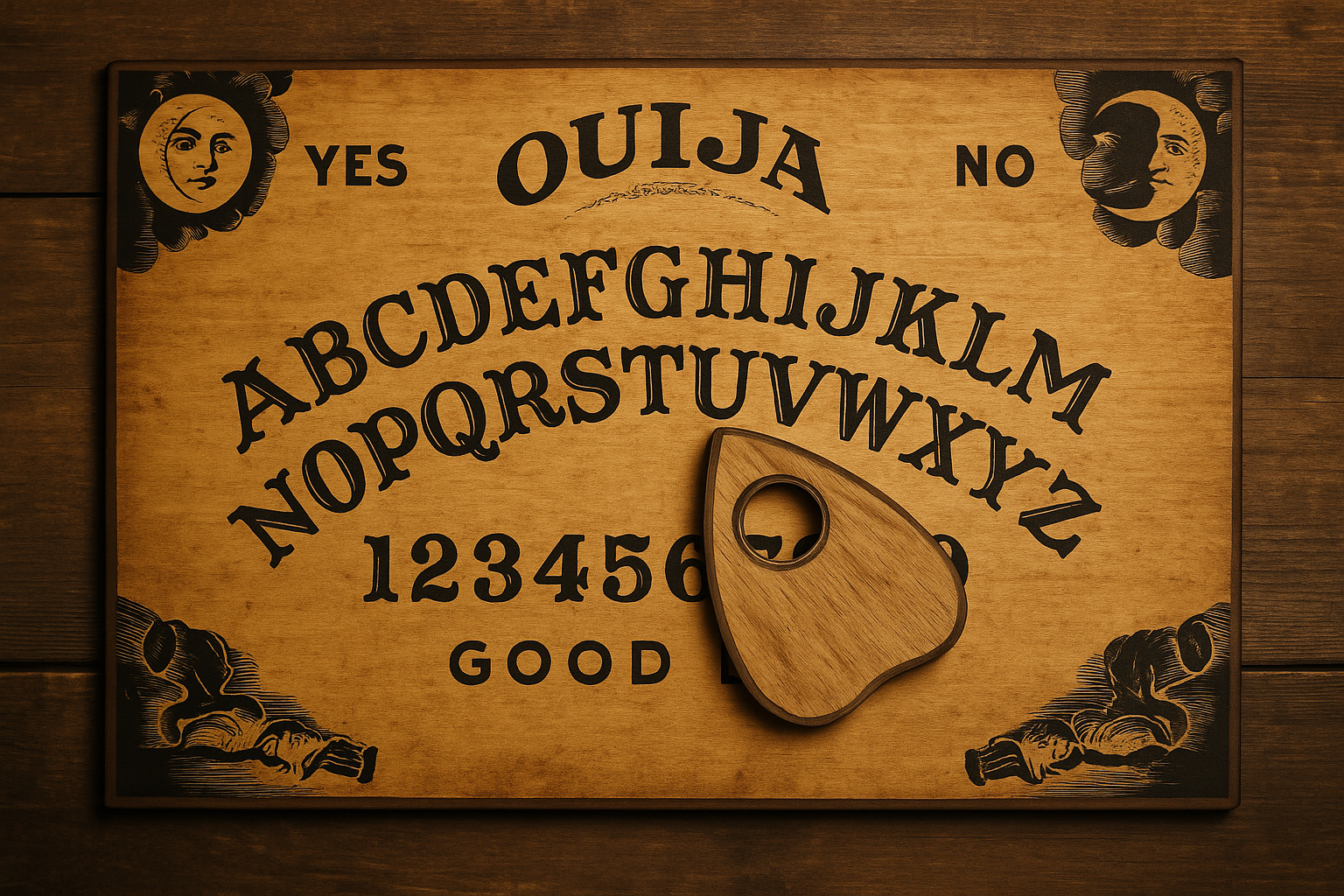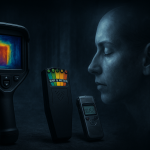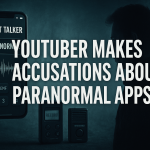Few items in the world of the paranormal spark as much fascination and fear as the Ouija board. Often sold as a game, yet treated with reverence (and sometimes dread) by investigators and believers, the Ouija board sits at the strange crossroads of entertainment, folklore, and alleged supernatural communication.
A Deeper History
The commercial Ouija board as we know it was patented in 1891 by attorney Elijah Bond, and marketed by the Kennard Novelty Company in Baltimore. Later, businessman William Fuld took over production, and his name became closely linked with the board for decades.
But the idea behind it wasn’t new. Similar practices of attempting to communicate with the dead using written or spelled messages existed long before.
- China (c. 400 AD onward): Early forms of spirit writing, known as fuji (扶乩, “planchette writing”), were recorded as far back as the Liu Song dynasty (5th century). By the Song dynasty (960–1279), the practice was well established: a stylus or stick was suspended and believed to trace Chinese characters in sand or ashes under the guidance of spirits. Through the Ming and Qing dynasties (1368–1912), fuji flourished, producing spiritual texts and even being practiced by scholars for poetry and divination.
- Europe (Middle Ages – 17th century): While not directly using boards, European occult traditions contained parallels. Medieval and Renaissance practitioners experimented with necromancy, divination, and written spirit communication through magical texts and grimoires. The Magical Treatise of Solomon (15th century) is one example, describing rituals to summon spirits. In the Renaissance, spirit invocation, angelic communication, and symbolic writing became popular among occultists.
- Spiritualist Movement (18th–19th centuries): Before the Ouija’s invention, mediums often used alphabet boards, table-turning, or pendulums to spell out answers during séances. These practices paved the way for “talking boards” in America by the 1880s.
- 1891 Patent: The Ouija board was formally patented, turning what had been folk and occult practices into a commercial product.
- 1966: After decades of production by the Fuld family, the rights to Ouija were sold to Parker Brothers.
- 1991 to Present: Parker Brothers was absorbed into Hasbro, Inc., which continues to own the Ouija® trademark and market the board worldwide.
So, while the Ouija board wasn’t invented out of thin air in the 1890s, its patent turned an ancient and widespread idea—communicating with the unseen through writing—into a household name, and its later mass-market production ensured its place in popular culture.
How It Works
The Ouija board is more than a simple game. It is seen as a channel of communication — a bridge between the living and the spirit world.
When participants lightly rest their fingertips on the planchette, they are thought to create an energy link that spirits can use to guide movement. The planchette’s gliding across the board isn’t random: it’s believed to be directed by unseen forces, spelling out answers, names, or messages.
Some investigators suggest the board works because spirits manipulate the collective energy of the group, while others describe the planchette as a kind of antenna that spirits can influence. The process often feels purposeful — letters forming into words, numbers providing dates, and responses aligning directly with questions asked.
Believers argue that this form of communication can provide comfort, clarity, or even warnings. Many describe Ouija sessions where responses included personal details or knowledge the participants couldn’t have known otherwise — strengthening the idea that the board is a genuine medium of contact.
Using the Ouija Board as a Communication Technique
For paranormal investigators, the Ouija board can be viewed as one more tool in a larger investigative toolkit. Much like EVP (electronic voice phenomena), spirit boxes, or dowsing rods, it’s essentially an interface for potential communication.
When used thoughtfully, it can:
- Allow a group of people to focus their attention on a single method of response.
- Generate letters or words that can be documented and analysed alongside other evidence (audio, video, environmental data).
- Act as a structured technique for asking questions in a session, much like controlled call-and-response experiments.
Some investigators pair Ouija sessions with cameras, EMF meters, or voice recorders to see if unusual readings coincide with responses on the board.
Beliefs About Negative or Demonic Entities
While many participants believe they’re contacting loved ones or neutral spirits, there is also a long-standing belief—especially in religious and occult circles—that Ouija boards can attract malevolent or deceptive entities. In some traditions, any spirit contact without protective rituals is seen as opening a door to unwanted forces.
Common cautions voiced by believers include:
- Spirits contacted may pretend to be loved ones to gain trust.
- Some entities could be hostile or “demonic” (in the religious sense) rather than benign.
- Failing to “close” a session properly may leave an “open invitation” for activity to continue.
Whether or not one believes these warnings, they are a big part of the Ouija board’s cultural reputation and help explain why some people avoid it entirely.
The Reputation of the Ouija Board
The Ouija board carries a cultural weight unlike many other paranormal tools. While some treat it casually, others believe it can open dangerous doors — inviting in negative energies or entities. Countless stories tell of eerie experiences: chilling messages, sudden changes in atmosphere, or unexplained disturbances after a session.
Hollywood has amplified this reputation, portraying the Ouija as a sinister object in countless horror films. Yet for many, it remains simply a fascinating curiosity — one that straddles the line between myth and mystery.
Conclusion
The Ouija board’s true nature is still debated. Is it a psychological trick, a powerful tool for contacting the unknown, or something in between? Perhaps its mystery lies in its dual identity: a mass-produced toy with a reputation for touching the supernatural. Whether you believe in it or not, one thing is certain — the Ouija board continues to fascinate, frighten, and fuel discussions in both paranormal and mainstream circles.
Tech vs. Natural Senses: Why Technology Is the Superior Tool in Paranormal Investigation
For as long as people have been exploring the unknown, there’s been an ongoing debate: ... Read more
Conspiracy Theorist YouTuber Makes Accusations About Paranormal Apps
A YouTuber recently released a video attacking ghost-hunting tools and apps — while showing Spirit ... Read more


